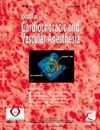肺动脉导管置入术导致的肺动脉假性动脉瘤:解决危及生命并发症的微创新方法。
IF 2.3
4区 医学
Q2 ANESTHESIOLOGY
Journal of cardiothoracic and vascular anesthesia
Pub Date : 2025-01-01
DOI:10.1053/j.jvca.2024.10.017
引用次数: 0
摘要
本文讨论了心脏手术肺动脉导管(PAC)置入后形成的肺动脉假性动脉瘤(PAP)。患者是一名 82 岁的女性,有高血压和慢性心力衰竭病史,接受了二尖瓣和三尖瓣择期手术。术后观察到气管导管出血,表明可能出现并发症。纤维支气管镜检查发现出血主要发生在右支气管。随后进行的计算机断层扫描肺血管造影(CTPA)证实,肺动脉分支存在一个小的假性动脉瘤。麻醉科医生、心脏外科医生和介入放射科医生迅速合作,采用微创方法,利用 PAC 作为到达 PAP 的导引导管,成功栓塞了假性动脉瘤。文章概述了 PAP 形成的潜在原因、临床表现和处理策略。文章讨论了保守治疗、手术治疗和介入治疗方法,但线圈栓塞因其有效性和微创性而成为首选治疗方法。作者强调了快速诊断、多学科协作的重要性,以及使用肺动脉栓塞途径快速到达病灶以稳定病情的可行性。总之,该病例展示了通过及时干预和团队协作成功解决危及生命的并发症的过程。本文章由计算机程序翻译,如有差异,请以英文原文为准。
Pulmonary Artery Pseudoaneurysm Due to Pulmonary Artery Catheter Placement: A New Minimally Invasive Approach to Solve a Life-threatening Complication
This article discusses a pulmonary artery pseudoaneurysm (PAP) formation following pulmonary artery catheter (PAC) placement for cardiac surgery. The patient, an 82-year-old female with a history of hypertension and chronic heart failure, underwent elective mitral and tricuspid valve surgery. After surgery, bleeding was observed in the endotracheal tube, indicating a potential complication. Fiberoptic bronchoscopy revealed bleeding mainly in the right bronchus. Subsequent computed tomography pulmonary angiogram (CTPA) confirmed the presence of a small pseudoaneurysm in a branch of the pulmonary artery. Prompt collaboration between anesthesiologists, cardiac surgeons, and interventional radiologists led to the successful embolization of the pseudoaneurysm with a minimally invasive approach by using the PAC as a guide catheter to reach the PAP.
The article outlines the potential causes of PAP formation, clinical presentation, and management strategies. While conservative, surgical, and interventional approaches are discussed, the preferred treatment is coil embolization due to its effectiveness and minimal invasiveness. The authors emphasize the importance of rapid diagnosis, multidisciplinary collaboration, and the feasibility of using the pulmonary artery route for embolization to rapidly reach the lesion to stabilize. Overall, the case demonstrates the successful resolution of a life-threatening complication through timely intervention and coordinated teamwork.
求助全文
通过发布文献求助,成功后即可免费获取论文全文。
去求助
来源期刊
CiteScore
4.80
自引率
17.90%
发文量
606
审稿时长
37 days
期刊介绍:
The Journal of Cardiothoracic and Vascular Anesthesia is primarily aimed at anesthesiologists who deal with patients undergoing cardiac, thoracic or vascular surgical procedures. JCVA features a multidisciplinary approach, with contributions from cardiac, vascular and thoracic surgeons, cardiologists, and other related specialists. Emphasis is placed on rapid publication of clinically relevant material.

 求助内容:
求助内容: 应助结果提醒方式:
应助结果提醒方式:


